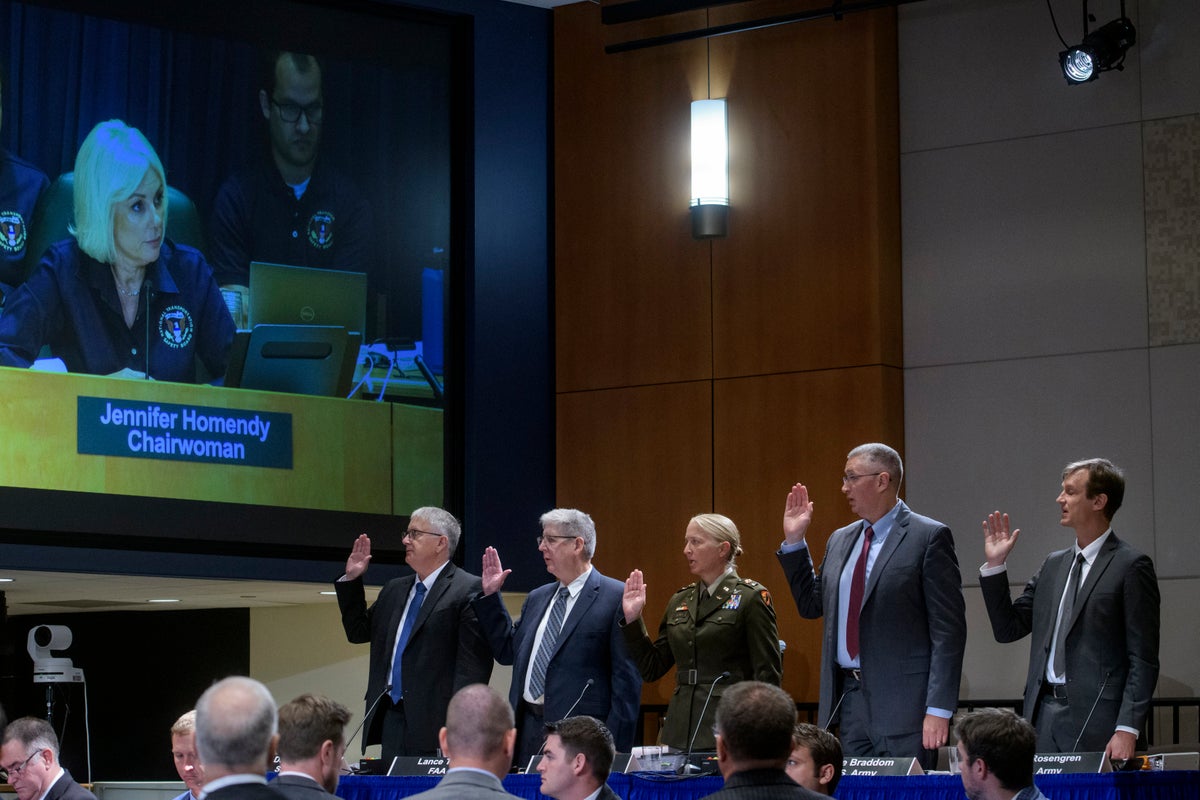
The National Transportation Safety Board enters a second day of public hearings Thursday on the January midair collision between an Army Black Hawk helicopter and a passenger plane that killed all 67 people aboard the aircrafts.
On the first day, investigators highlighted a number of factors that may have contributed to the crash and the warnings about helicopter traffic that FAA received years before the tragedy over the Potomac River.
It’s too early for the board to identify what exactly caused the crash. The board’s final report won’t be released until sometime next year. But it became clear Wednesday how small a margin of error there was for helicopters flying the route the Black Hawk took the night of the nation’s deadliest plane crash since November 2001.
The January incident was the first in a string of crashes and near misses this year that have alarmed officials and the traveling public, despite statistics that still show flying remains the safest form of transportation.
FAA didn't add warning to helicopter charts, official says
NTSB Chairwoman Jennifer Homendy said an FAA working group raised concerns about all the helicopter traffic around Reagan airport and the risk of a collision in 2022, but the FAA refused to add a warning to helicopter charts urging pilots to use caution when this runway was in use.
“This is the very event that this would have been the cautionary note for,” she said.
Video and animation presented during the proceeding's first day showed the helicopter flying above the 200 feet (61 meters) altitude limit before colliding with the plane.
Investigators said Wednesday the flight data recorder showed the helicopter was actually 80 feet to 100 feet (24 to 30 meters) higher than the barometric altimeter the pilots relied upon showed they were flying. So the NTSB conducted tests on three other helicopters from the same unit in a flight over the same area and found similar discrepancies in their altimeters.
Dan Cooper with Sikorsky helicopters said that when the Black Hawk helicopter involved in the crash was designed in the 1970s, it used a style of altimeter that was common at the time. Newer helicopters have air data computers that didn’t exist back then that help provide more accurate altitude readings.
Chief Warrant Officer Kylene Lewis told the board that she wouldn’t find an 80 to 100 foot discrepancy between the different altimeters on a helicopter alarming because at lower altitudes she would be relying more on the radar altimeter than the barometric altimeter. Below 500 feet (152 meters), Lewis said she would be checking both instruments and cross referencing them.
Army officials said a discrepancy of 70 to 100 feet (21 to 30 meters) between the Black Hawk’s altimeters is within the acceptable range because pilots are expected to maintain their altitude plus or minus 100 feet.
Concern about distances between planes and helicopters
The greater concern is that the FAA approved routes around Reagan airport that included such small separation distances between helicopters and planes when planes are landing.
“The fact that we have less than 500 foot separation is a concern for me,” said Scott Rosengren, who is chief engineer in the office that manages the Army's utility helicopters.
During the two minutes before the crash, one air traffic controller was directing airport traffic and helicopters in the area, a task that involved speaking to or receiving communications from several different aircraft, according to the NTSB’s History of Flight Performance Study.
The air traffic controller had spoken to or received communications from the Black Hawk helicopter, an airplane that was taking off, an Air Force helicopter, an airplane on the ground, a medical helicopter and an inbound flight that was not the American Airlines plane that would crash.
“All aircraft could hear the controller, but helicopters could only hear other helicopters on their frequency and airplanes only other airplanes,” the report stated. “This resulted in a number of stepped on transmissions as helicopters and airplanes were not aware when the other was communicating.”
Stepped on transmissions are those that are unheard or blocked because of other transmissions. The NTSB report provides a list of 29 separate communications between the airport tower and other aircraft during approximately the 1 minute and 57 seconds before the collision.
Previously disclosed air traffic control audio had the helicopter pilot telling the controller twice that they saw the airplane and would avoid it.
The animation ended with surveillance video showing the helicopter colliding with the plane in a fiery crash.
Investigations have already shown the FAA failed to recognize a troubling history of 85 near misses around Ronald Reagan National Airport in the years before the collision, and that the Army’s helicopters routinely flew around the nation’s capital with a key piece of locating equipment, known as ADS-B Out, turned off.
___
Associated Press writers Leah Askarinam, Ben Finley and Rio Yamat contributed to this story.
NTSB hearing reveals more details of DC mid-air collision that killed 67 people
Long-serving ex-Tory MP Adam Holloway joins Reform
NTSB launches hearings on deadly Washington collision between a helicopter and passenger plane
NTSB hearings will focus on fatal Army helicopter-passenger jet crash. Here's what to know
Chinese researchers suggest lasers and sabotage to counter Musk’s Starlink satellites
Ozzy Osbourne funeral latest: Sharon and Metallica stars attend private service







